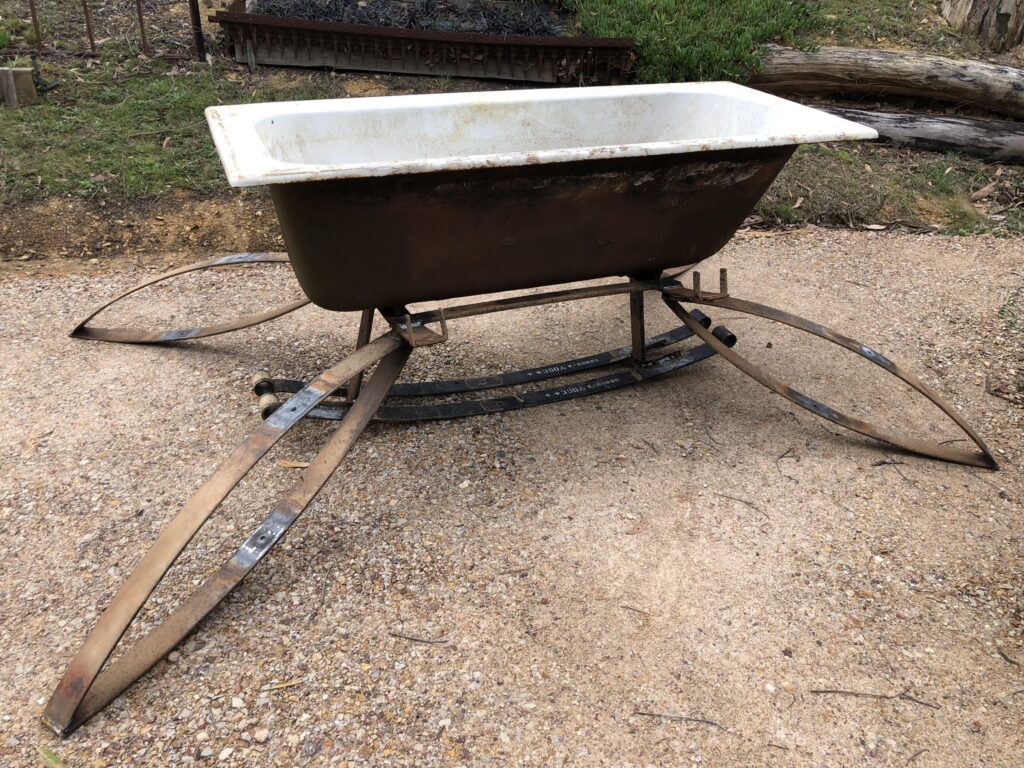Welcome to my blog, gallery, and archive – a collection of things I’ve designed and made over the years.
You’ll find a range of technical projects here, complete with instructions, code, circuits, 3D files, and more—everything you’d need to build one yourself if you’re so inclined.
There’s also a gallery showcasing garden art we’ve created, primarily using found objects, installed throughout our bush property.
Additionally, you’ll find some of my older photography works, along with material from the RoboCup initiative I was involved in many years ago.
Mark Makies
All Original Content © 1983 – 2025 by Mark Makies
Licensed under CC BY-SA 4.0


This project brings new life to two forgotten relics – a set of old LandCruiser leaf springs and a cast iron bathtub buried in the bush for over 20 years.
The result: a unique freestanding outdoor bath that looks like it walked out of a Mad Max movie. It’s equal parts bush mechanic, steampunk creature, and backyard art piece.

Pulse Induction Metal Detector
I had just finished designing and prototyping Roverling MkII. I had many ideas for its first mission, but a friend suggested using it as a metal detector, that was over a year ago and it is still a work in progress
This is a Work In Progress – feel free to follow along

Runner-Up on Instructables Anything Goes Competition, Feb 2025
Featured on Instructables
Ever wanted to create your own language or scripts. Look no further, you can now with these software tools.

I designed Roverling Mark II so I could experiment with a cheap, practical, configurable, and reliable mobile platform. It’s a semi-autonomous, multi-terrain mobile robotic platform, almost entirely 3D printed.

Built almost entirely from my old CTC 3D printer, once I replaced it with a Prusa i3 MK3s+.
Great use for all these parts that would have been otherwise thrown away.

I wanted to make something artistic and dynamic using an 8×8 matrix of RGB LED’s, that I recently discovered.
I used a cheap RP2040 MCU module, programmed in Python to produce the random patterns. I just played around with numbers and algorithms until I liked the look of them.

I made a VERY loud portable motor-driven siren because:
- I had some spare RC parts, I’m a big fan of repurposing functional bits rather than throwing them out.
- I just got my first new 3D printer, a Prusa
- I wanted to make something cool.
- And finally I saw a picture of an air raid siren, I thought, “I can make that “

We live on a rural property and have around 20 -40 wild ducks around at any one time.
We have a large dam and jetty, however it is almost unusable due to all the duck poo. So I decided to make a duck scarcer/repellent.
It uses both a passive IR and a microwave presence sensor to detect ducks. Once triggered it delivers and light and sound show for 10 seconds, if within that time period there is still activity, it changes into Blast mode and really ups the shock and awe for another 10 seconds.

Last autumn the weather was cold and crap so I decided to design a tile based system for basic gears and movements. Mainly to teach the kids basic mechanics.
There was no real overall plan, just design and add another tile when I had time.

Something that has evolved from thrown away door latch solenoids and my dream as a kid to build a pinball machine.
It is very fast and shoots tiny ball bearing around through the clear tubes

My attempts at printing components for an Electric Ducted Fan, with an aim of creating a vertical take off thing.
It didn’t work that well, but sure pushes a lot of air around. See video.

Nothing metal gets thrown away around here.
Checkout our Garden Art. No instructions here, but lots of ideas.

A collection of some of my printed photographs

1990’s early robot designs whilst I was working at RMIT Uni
